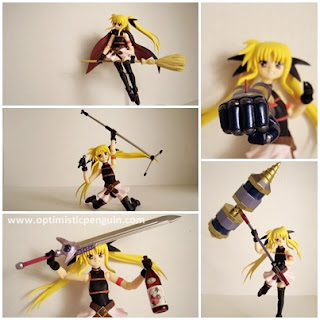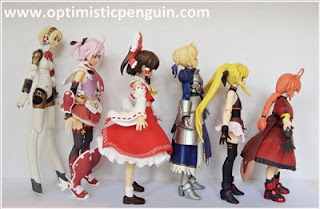Fate is a naive girl who was abused by her ruthless mother Precia, however Fate remained blindly loyal to Precia and searched for the Jewel Seeds. This search made her cross ways with Nanoha, who through dedication helped reform Fate into her true self, after the revelation that she is a clone with implanted memories she teams up with Nanoha for the rest of the Magical Girl series. Fate is a quiet and reflective person. In Nanoha A's Fate is adopted by Lindy and changes her name to Fate T. Harlaown, and in StrikerS she becomes the leader of the Lightning squadron at the Time-Space Administration Bureau. Fate's intelligent device Bardiche, Bardiche is a battle axe which can transform into a number of different attack modes
Fate comes in a standard Figma box.
On the front is a window for viewing the figure, on one side is the Figma logo, on the other is a picture of the figure, on the back there is relevant information, all in Japanese, and pictures of the figure in various poses with their various accessories. Instructions for swapping face pieces and other items are usually printed on either inside of the box tabs or on a piece of paper slipped inside the packaging. Also take note that all figures you purchase have the correct authentication printed or stickered on the box.
Inside the box the figure is held between two pieces of moulded plastic, with spaces for their accessories. The extra hands and the base of the Figma stand are stored in plastic bags underneath the figure in the plastic moulding. Figures are usually wrapped with plastic in certain areas to protect the paint. Boxes also come with inserts which act as backdrops in the box and can be taken out and used for backdrops while displaying figures. Fate's backdrop is a blue starry sky. Fate also comes with a special cut-out to use of the Di: Stage.
Figma’s also are supplied with a small zip-lock bag to store all the accessories in, the name of the figure can be written on this bag so that figure accessories can be stored neatly. Figma’s also come with a neat little device for storing the extra hands in.
Packaging = 7/10
Fate comes with the standard Figma stand. Made of clear plastic it has three points of articulation which move forwards and back on hinge joints, one joint is at the bottom where it plugs into the base, one in the middle and one where it plugs into the Figma. The articulation of the stand allows the Figma to be posed in a variety of dynamic poses, and because it is clear it does not interfere with the aesthetic of taking dynamic and exciting photos. Fate's cloak has a hole in the back where you plug her stand into and then into her back, holding her and her cloak securely to the stand. Fate also comes with a clear peg to use with her cloak when she is not on her stand, the peg plugs into her back through the cloak so that her cloak is securely attached to her back.
Stand = 7/10
Sculpt:
This is Fate Testarossa The Movie 1st Version.
Fate's overall design is nice, she is wearing minimal clothing and is slim and tall, for a small child Figma that is.
Starting from the top, her hair is nicely done, with blown in the wind strands with the end of her ponytails being a little soft to prevent them from breaking easily. Her body is slim and her stomach is sculpted particularly nice with her belly-button showing as her clothes are skin tight, her skirt is shaped nicely with ripples and waves in it, and her belt has nice detail. She then has thigh-highs and some very simple yet nice boots with lovely red ribbon on them, her gloves are simple too but with nice detailing on the hand.
Her cloak, which is sculpted in a wind-blown style, can be removed. Her cloak also has soft PVC around the neck and colour allowing her to move her neck freely when the cloak is attached. Fate's skirt can also be removed to show her leotard like clothing with soft PVC black panties.
Over all a nice design and sculpt.
Sculpt = 8/10
Paint:
Fate has a simple yet effective colour scheme, it is dramatic with mainly black, with details of red and gold, with a white skirt, this set against her blonde hair makes her a visually dramatic and appealing figure. As for the paint job her red and gold detailing is good in some places but in other it is messy or it looks like it needs another layer of paint, her black ribbons are also messy where the black meets the blonde. On the plus side her face's are painted well and her skirt has some nice shading and depth.
Paint = 7/10
Articulation:
Fate use’s the standard Figma joint system. Figma joints are hinge joints with pegs on either end allowing both forward and back movement and rotation.
At the head a Figma joint is used at the top of the neck allowing the figure to look up and down and turn their head left and right, however looking up is restricted somewhat by the design of the back of the hair. To change the faces on Figma’s the front piece of hair is removed and then the faces can be taken of and swapped.
The shoulder consists of a double joint, a ball joint which sits inside the upper body, this is attached to a ball shaped Figma joint which acts as the shoulder, and this allows full range of motion to the shoulder. Further down a Figma joint is used as the elbow and bends in and then out straight and there is some slight rotation for the lower arm to turn in and out. At the wrist the various hands plug into a small hole at the end of the arm. Each hand also has a hinge joint, which not only allows the hand to rotate but also to move up and down which gives the figure realistic wrist movement.
A waist joint is located under her chest. Waist joints are ball and socket joints, a ball joint will be attached to the upper body and which plug into a socket in the main torso, this gives the body twisting movement and bending forwards and back. At the hips a three jointed ball and socket joint is used. One ball plugs into a socket at the bottom of the torso acting as the hip joint; this allows the hips to turn side to side, lean forward or back, then on each of the other two ball joints the legs plug on. Each leg has an inner socket which the ball joint plugs into, this piece allows full range of motion from the ball joint and also allows the thigh to turn in and out as it pegs inside the main leg piece.
A Figma joint is then used as the knee allowing the knee to bend backwards and then out to straight, and there is some slight rotation for the lower leg to turn in and out. The ankle also is a Figma joint allowing the foot to point and flex turn in and out.
Fate also has articulation in each of her ponytails, which is a peg and ball joint, allowing her ponytails to move in all directions. Fate also has two points of articulation in her cloak, each side of her cloak has a Figma joint, this gives the cloak some movement when posing.
Pose:
Fate is therefore highly posable and can be posed in a variety of ways. With the use of the accessories supplied, her Bardiche, she can be displayed in a number of poses, she can be ready to strike with her Grave Form, in mid swing with Scythe Form, battle prepared with Axe Form. However there are a few areas in which articulation is restricted, while Fate is wearing her cloak her arm movements are restricted somewhat, however when she is not wearing her cloak she has no restrictions in design, another area of restriction is that although her cloak has two points of articulation the movement is minimal, so a nice thought by Max Factory to articulated the cloak but poor execution in the actual range of movement the articulation allows.
Articulation & Pose = 9/10
Enjoyment:
I will break down enjoyment into two categories: Accessories and Play Value.
Accessories:
Fate comes with three facial expressions; a plain content expression, and a teeth gritted angry expression. Fate also comes with an assortment of hands; a pair of open hands, a pair of fists, a pair of relaxed hands, two pairs of hands for holding items.
Fate also comes with her intelligent device Bardiche with attachments for all its forms, Axe Form, where Bardiche is in a simple Axe shape, Scythe Form, also known as Arc Saber a melee attack consisting of a blade scythe blade of light coming from Bardiche, another attack in this form is Scythe Slash, and lastly Grave Form, also known as, Thunder Rage, a multi-target attack.
Fate also has a alternative fringe piece with her hair more wind-blown.
To use the different form the top of Bardiche is unplugged from the staff, the hands slide on and then a new form is plugged onto the top of the staff. Max Factory even supplied two pairs of holding hands one smaller for holding her Bardiche securely, and another pair for holding things looser and also they can be used to hold a number of accessories which belong to other Figma's.
Play Value:
I will break down play value into two categories: Compatibility, with other figures and accessories, and general play.
Compatibility:
Because Fate's hands for holding items are not completely closed she is able to hold practically any other Figma item. She can go for a ride on Reimu's broom, rock n roll with Miku's microphone, use Signum, Vita, Cute, and Saber's weapons, as well as play around with Miku's leeks and Reimu's sake, she can even use Aegi's rocket punch. Vita and Miku's face's can also fit Fate's face.
Next up is a height comparison, as you can see she is on the short side of the Figma height scale, and is around the same height as Vita.
General Play:
In general Fate is a fun figure, she is easy to pose, however she is easier to pose when her cloak is not attached as her cloak tends to make posing difficult so it's best to pose then attach the cloak. Fate's range of forms for Bardiche also give her a lot of dramatic diversity. Fate has character and spunk and will fit in nicely with my other Figma's.
Overall Fate is an enjoyable figure, beautiful and little and full of attitude.
Enjoyment = 8/10
Over all Fate scores 7.7/10




















